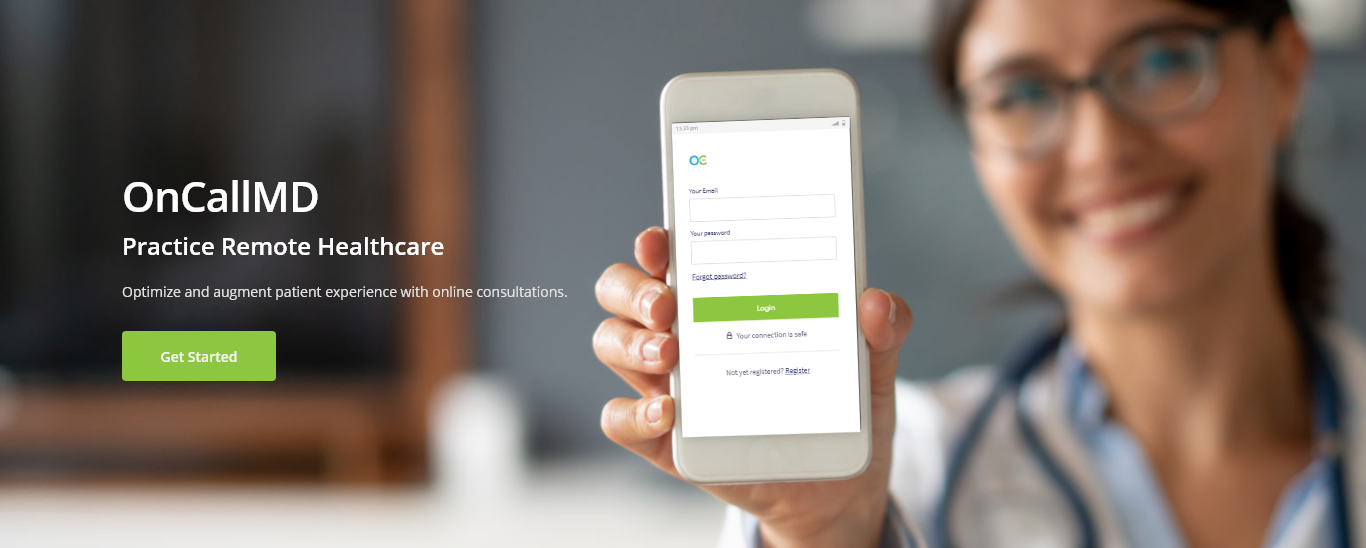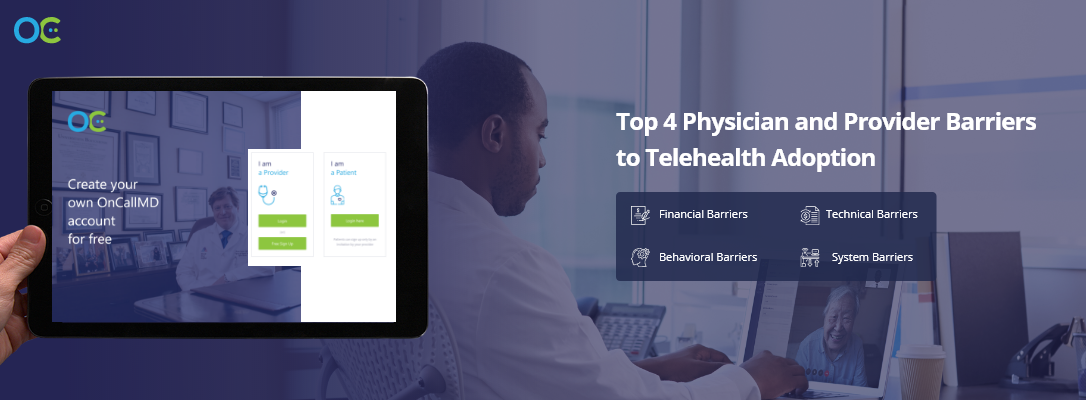

In the current pandemic, telehealth has demonstrated tremendous potential to fulfill the Triple Aim of Healthcare. It helps improve patient experience, health outcomes, and reduces per capita cost in healthcare delivery, especially in rural and remote parts of the country. According to American Well’s Telehealth Index 2019, though less than 1% of doctor’s visits accounted for e-visits in 2015, the adoption rate of video visits on telehealth platforms increased by 340% in the last five years.
Physician and provider reluctance to offer telehealth services emanates from a multitude of actual and perceived obstacles in the industry. The most common barriers cited for avoiding telehealth utilization include financial barriers, technical barriers, behavioral barriers and system barriers. OnCallMD is a solution-driven telehealth platform that has overcome these issues to allow physicians/providers and patients to successfully, and easily, participate in telehealth visits.
The biggest barrier to telehealth adoption has been a lack of reimbursement for the service. Although U.S policymakers are allowing full reimbursement for telehealth services during the coronavirus pandemic, payers, providers, and patients are still uncertain about spending their time and resources adopting telehealth due to past experiences in which it has not been reimbursed and the uncertainty regarding reimbursement once the pandemic ends. The commercial insurers are now inconsistently paying for telehealth visits, which is better than prior to the pandemic, but will probably revert to infrequent remuneration similar to that of pre-pandemic times once the pandemic ends. Until all third party payers permanently agree to pay for telehealth visits, reimbursement will remain a major barrier to utilization by physicians and providers.
In order to accelerate physician and provider adoption of telehealth, OnCallMD has eliminated this obstacle of payment uncertainty by developing a proprietary payment processing gateway that guarantees that the physician/provider will be paid by the patient’s insurance company or by the patient directly when a telehealth visit occurs. Thus, OnCallMD users are able to confidently practice telehealth knowing that they will be paid for the expert service that they are providing regardless of the third party payer coverage.
Providers in the U.S face very few direct technical challenges to adopt telehealth unless they live in a rural area with poor internet access and inadequate bandwidth because all that is necessary is a computer with a good processer and high-speed internet access. Although adequate internet bandwidth is an infrequent problem in urban areas, physicians and patients do experience dropped video calls due to poor internet connectivity or browser incompatibility. OnCallMD has overcome this obstacle by developing a unique process that allows patients to reconnect a visit immediately if their visit was disconnected prematurely due to a technical problem thereby eliminating this point of frustration. In rural areas, telehealth can be challenging due to high speed internet access issues. This is a problem that can’t be addressed by any telehealth platform. It is a problem for which solutions are being developed by governmental authorities and private businesses. Some exciting solutions are on the horizon, but they are beyond the current discussion.
Another technical challenge is a lack of technical competence and a lack of confidence in adapting to the telehealth software platform. Implementing an intuitive platform is extremely important to prevent frustrations encountered with complex designs that are presented by many of the software platforms that are currently in the marketplace. Encountering these frustrations discourages use. Finding a simple, intuitive platform like OnCallMD is critical to successful telehealth adoption.
A critical technical barrier in the telehealth environment is the current lack of access to a patient’s private physician/provider after-hours and on weekends. Since medical offices are only open about 30% of the week, patients are left with no after-hours alternative for care except to obtain it from emergency rooms, urgent care centers, clinics at pharmacies or from a random telehealth provider. Studies indicate that 60% of patients will not use telehealth if they don’t have access to their own physician/provider or one designated by their physician/provider. This lack of after-hours accessibility results in expensive care for the patient from an unfamiliar provider. It also represents a lost source of revenue for the physician/provider since the patient must leave the physician’s/provider’s “care loop” to obtain treatment. OnCallMD has created a proprietary solution that overcomes this major obstacle. This solution allows the physician/provider to extend office hours to 24/7 virtual accessibility to himself or herself or to a designated covering colleague(s). This exciting solution also allows the physician/provider to reduce overhead by eliminating the practice’s answering service. This saves $200 – $300 per month per physician/provider.
Behavioral barriers result from a lack of familiarity related to telehealth workflow and uncertainty about online security. Utilizing a HIPAA-complaint, cyber-secure telehealth software platform can ensure patient data security and privacy resulting in a better adoption rate. Telehealth workflow issues can be easily overcome by working with a colleague who has successfully adopted a telehealth protocol or by implementing an intuitive telehealth platform like OnCallMD that provides experienced customer support to help educate users about the platform and how to successfully integrate it into their practices along with providing marketing support to create awareness of the availability of the service.
System barriers result from regulatory issues pertaining to licensure and reimbursement. The issues with reimbursement have been extensively discussed above, but it is important to mention that over 30 states have already passed legislation requiring third party payers to reimburse for telehealth visits at parity (i.e., the same as an office visit). Unfortunately, the third party payers have consistently chosen to ignore these mandates.
There are currently no specific licensing or credentialing issues for physicians/providers to offer telehealth services in their state of licensure. However, if the physicians/providers want to provide telehealth services to patients outside of their state of licensure, they need to obtain licenses in each additional state in which they would like to provide virtual care. Fortunately, some states are beginning to offer licensure reciprocation for telehealth providers to ease the burden of practicing telehealth on a grander scale.
When a physician/provider creates an OnCallMD telehealth account, the software system automatically validates that the physician/provider is licenced in the various jurisdictions in which he/she proclaims licensure. This allows physicians/providers to immediately implement telehealth, charge for the visits and e-prescribe from the OnCallMD software platform.
Learn more about how OnCallMD’s powerful, physician/provider-centric and solution-driven telehealth platform allows you to successfully and securely launch a successful telehealth component for your practice by eliminating the obstacles of telehealth. Our goal is to create a positive impact on healthcare by providing positive telehealth experiences for patients and physicians/providers and to extend its capabilities for more substantial utilization.